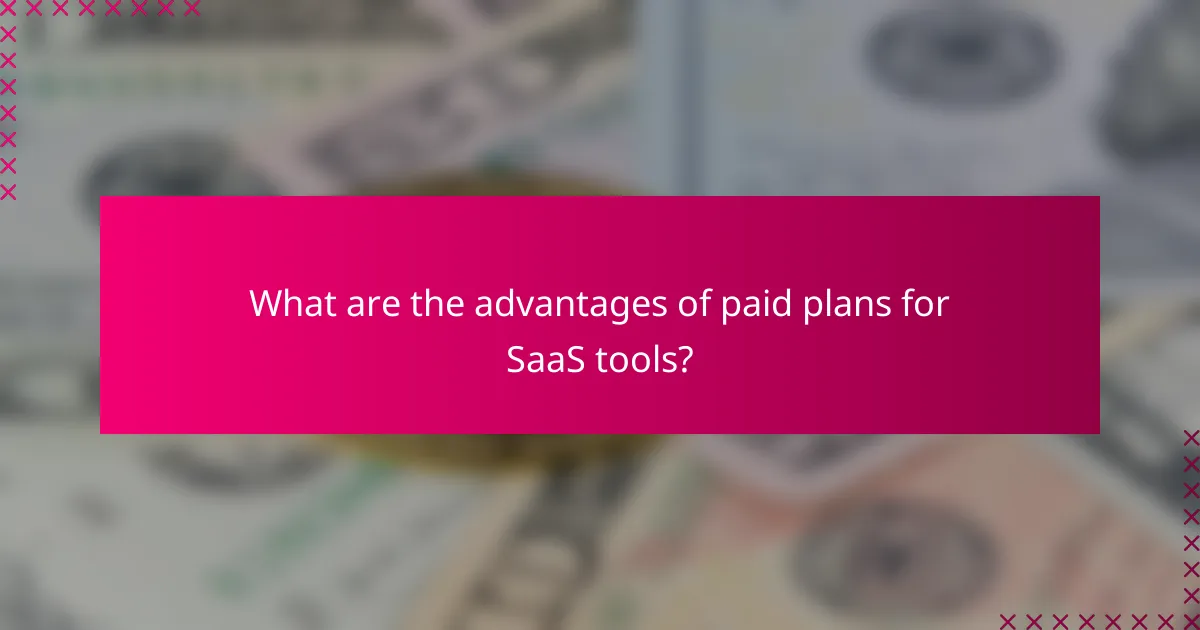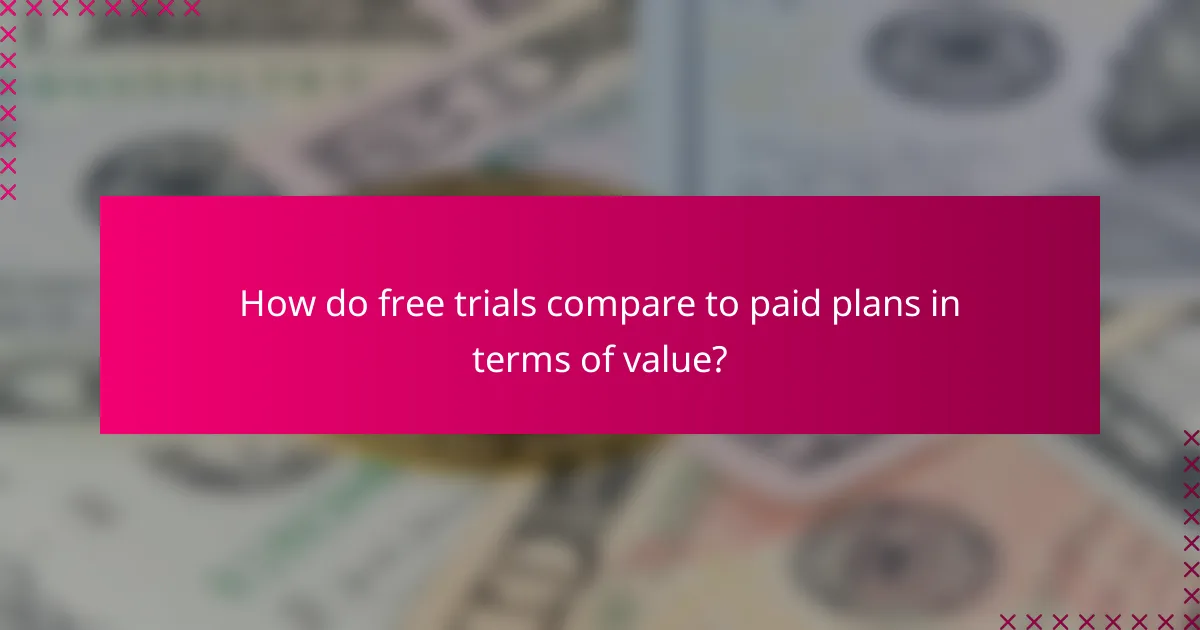When considering software as a service (SaaS) options, users often face the choice between free trials and paid plans. Free trials allow potential customers to explore essential features without financial commitment, while paid plans offer comprehensive access, enhanced support, and improved security. Understanding the limitations and benefits of each option is crucial for making an informed decision that aligns with individual needs and budget constraints.

What are the key features of free trials in SaaS tools?
Free trials in SaaS tools offer users a chance to explore the software without any financial obligation. These trials typically provide access to essential features for a limited time, allowing users to evaluate the tool’s suitability for their needs.
Access to core functionalities
Free trials usually grant users access to the core functionalities of the software, enabling them to experience the main features that define the product. This access helps potential customers assess whether the tool meets their specific requirements.
However, some trials may restrict access to advanced features or premium options, which could limit the overall evaluation experience. Users should check what functionalities are included in the trial to ensure they can make an informed decision.
Time-limited usage
Free trials are typically offered for a limited duration, often ranging from a week to a month. This time constraint encourages users to explore the software thoroughly within the given period.
It is essential for users to manage their time effectively during the trial to maximize their understanding of the tool. Setting aside dedicated time for exploration can help users evaluate the software’s capabilities and make a timely decision about purchasing a paid plan.
No financial commitment
One of the main advantages of free trials is that they require no financial commitment from users. This allows individuals and businesses to test the software without the risk of incurring costs.
However, users should be aware that some trials may require credit card information upfront. If users forget to cancel before the trial ends, they might incur charges for a subscription they did not intend to purchase.
Limited customer support
During a free trial, customer support may be limited compared to what is available for paid subscribers. Users might have access to basic support channels, such as FAQs or community forums, but direct assistance may not be as readily available.
Users should consider this limitation when evaluating the software, as having robust support can be crucial for resolving issues or questions that arise during the trial period.
Usage restrictions
Free trials often come with usage restrictions, such as limits on data storage, the number of users, or the frequency of certain features. These limitations can affect the overall experience and evaluation of the software.
Users should carefully review the terms of the trial to understand these restrictions. Knowing what is limited can help users gauge whether the software will meet their needs if they decide to upgrade to a paid plan.

What are the advantages of paid plans for SaaS tools?
Paid plans for SaaS tools offer several advantages, including comprehensive access to features, enhanced support, and improved security. These benefits can significantly enhance user experience and productivity compared to free trials.
Full access to all features
Paid plans typically provide complete access to all features of a SaaS tool, which is often limited in free trials. Users can take advantage of advanced functionalities that may be essential for their business operations, such as analytics, integrations, and automation tools.
For instance, a project management tool might include features like time tracking and resource allocation in its paid version, which are not available in the free trial. This full access allows teams to leverage the software’s capabilities fully, leading to better project outcomes.
Priority customer support
With paid plans, users often receive priority customer support, which can be crucial for resolving issues quickly. This means faster response times and dedicated support channels, ensuring that any disruptions to service are minimized.
For example, a business using a paid SaaS tool can expect to receive assistance within minutes, while free users might wait hours or even days. This level of support can be vital for maintaining productivity and addressing urgent needs.
Customizable options
Paid plans frequently offer customizable options that allow users to tailor the software to their specific needs. This can include personalized dashboards, custom workflows, and integration with other tools that are essential for business operations.
For instance, a marketing automation platform might allow users to create custom email templates and workflows that align with their branding and processes, enhancing overall effectiveness and user satisfaction.
Enhanced security measures
Security is a significant concern for businesses, and paid plans generally provide enhanced security measures. This can include features like data encryption, two-factor authentication, and compliance with industry standards such as GDPR or HIPAA.
Investing in a paid plan can help protect sensitive data and ensure that the software meets necessary regulatory requirements, which is particularly important for industries handling personal or financial information.
Regular updates and improvements
Paid plans often come with regular updates and improvements, ensuring that users benefit from the latest features and security enhancements. This continuous development helps keep the software competitive and aligned with user needs.
For example, a paid subscription might include quarterly updates that introduce new functionalities based on user feedback, while free users may have to wait longer for such enhancements. Staying updated can significantly improve user experience and operational efficiency.

How do free trials compare to paid plans in terms of value?
Free trials offer a way to test services without financial commitment, but paid plans typically provide more comprehensive features and support. The value of each option depends on user needs, budget constraints, and the specific features required for effective use.
Cost-effectiveness analysis
Free trials are an attractive option for users looking to explore a service without upfront costs. However, they often come with limited access to features, which can hinder the evaluation process. Paid plans, while requiring an investment, usually provide a broader range of functionalities that can justify the expense over time.
When considering cost-effectiveness, evaluate the potential return on investment (ROI) from a paid plan. If the service significantly enhances productivity or revenue, the monthly or annual fee may be worthwhile.
Long-term benefits of paid subscriptions
Paid subscriptions often include ongoing updates, customer support, and additional features that free trials lack. Users who commit to a paid plan can benefit from enhanced security, priority service, and access to new tools as they are developed. This long-term support can lead to more efficient use of the service.
Moreover, many paid plans offer scalability options, allowing businesses to expand their usage as they grow. This flexibility can be crucial for adapting to changing needs over time.
Risk of feature limitations
Free trials frequently limit access to key features, which can lead to an incomplete understanding of the service’s capabilities. Users may find themselves unable to fully utilize the product during the trial period, potentially leading to a poor assessment of its value.
It’s essential to identify which features are critical for your needs before starting a free trial. If the trial does not include these features, it may be more beneficial to opt for a paid plan from the outset.
Potential for upselling
Many services use free trials as a gateway to upsell paid plans. Users may initially be attracted to the free version but later discover that essential features require a subscription. This strategy can lead to frustration if users feel misled about the capabilities of the free trial.
To avoid pitfalls, assess the pricing structure and feature tiers before committing to a free trial. Understanding what is included in both free and paid options can help you make an informed decision about whether to upgrade.

What limitations should users consider with free trials?
Free trials often come with several limitations that can affect the user experience and overall value. Users should be aware of time constraints, restricted feature access, data retention policies, and inadequate support during the trial period.
Time constraints
Most free trials are time-limited, typically ranging from a few days to a month. This short duration can pressure users to evaluate the product quickly, potentially leading to rushed decisions. It’s essential to check the specific trial period and plan usage accordingly to maximize benefits.
For example, if a trial lasts only seven days, users should prioritize key features they want to test and allocate time to explore them thoroughly within that window.
Feature access limitations
Free trials often restrict access to certain features that are available only in paid plans. This limitation can hinder users from fully assessing the product’s capabilities. Users should identify which features are excluded and consider whether these are critical to their needs.
For instance, a software tool might allow only basic functionalities during the trial, while advanced analytics or integrations are reserved for paying customers. Understanding these limitations helps users make informed decisions about upgrading.
Data retention policies
Many free trials have specific data retention policies that dictate how long user data is stored. After the trial ends, data may be deleted or inaccessible unless a paid plan is adopted. Users should review these policies to avoid losing important information.
For example, if a trial allows users to create projects or store files, it’s crucial to know whether this data will be retained after the trial expires or if it will be permanently deleted.
Inadequate support
Support during free trials is often limited, with users receiving less assistance compared to paying customers. This can lead to frustration, especially if users encounter technical issues or have questions about the product. Users should assess the level of support available during the trial period.
For instance, some companies may offer only email support for free trial users, while paid plans might include live chat or phone support. Understanding these differences can help users gauge the level of help they can expect while evaluating the product.

What criteria should businesses use to choose between free trials and paid plans?
Businesses should consider their target audience, product complexity, and revenue goals when choosing between free trials and paid plans. Free trials can attract users by allowing them to test features without commitment, while paid plans often provide immediate revenue and access to premium features.
Understanding Free Trials
Free trials allow potential customers to use a product or service for a limited time without charge. This approach helps businesses demonstrate value and functionality, encouraging users to convert to paid plans after experiencing the benefits firsthand.
When implementing a free trial, consider the duration, which typically ranges from a week to a month. Ensure that the trial period is long enough for users to explore key features but short enough to create urgency for conversion.
Evaluating Paid Plans
Paid plans offer immediate access to all features and benefits of a product or service. They provide a steady revenue stream and can help businesses gauge customer commitment and readiness to invest in premium offerings.
When setting up paid plans, consider tiered pricing structures that cater to different user needs. For example, basic plans may include essential features, while premium plans could offer advanced functionalities and dedicated support.
Comparing Features and Limitations
Free trials often come with limitations, such as restricted access to certain features or a time cap. In contrast, paid plans typically provide full access and additional benefits like customer support or exclusive content.
Businesses should weigh the trade-offs: free trials can generate leads but may result in lower conversion rates, while paid plans can secure revenue upfront but may deter users who are hesitant to commit without testing the product.
Assessing Value for Customers
The value proposition for customers differs between free trials and paid plans. Free trials offer a risk-free way to evaluate a product, while paid plans emphasize the benefits of immediate access and support.
To maximize perceived value, ensure that both options clearly communicate benefits. For free trials, highlight what users can achieve during the trial period. For paid plans, emphasize long-term savings, premium features, and ongoing support.
